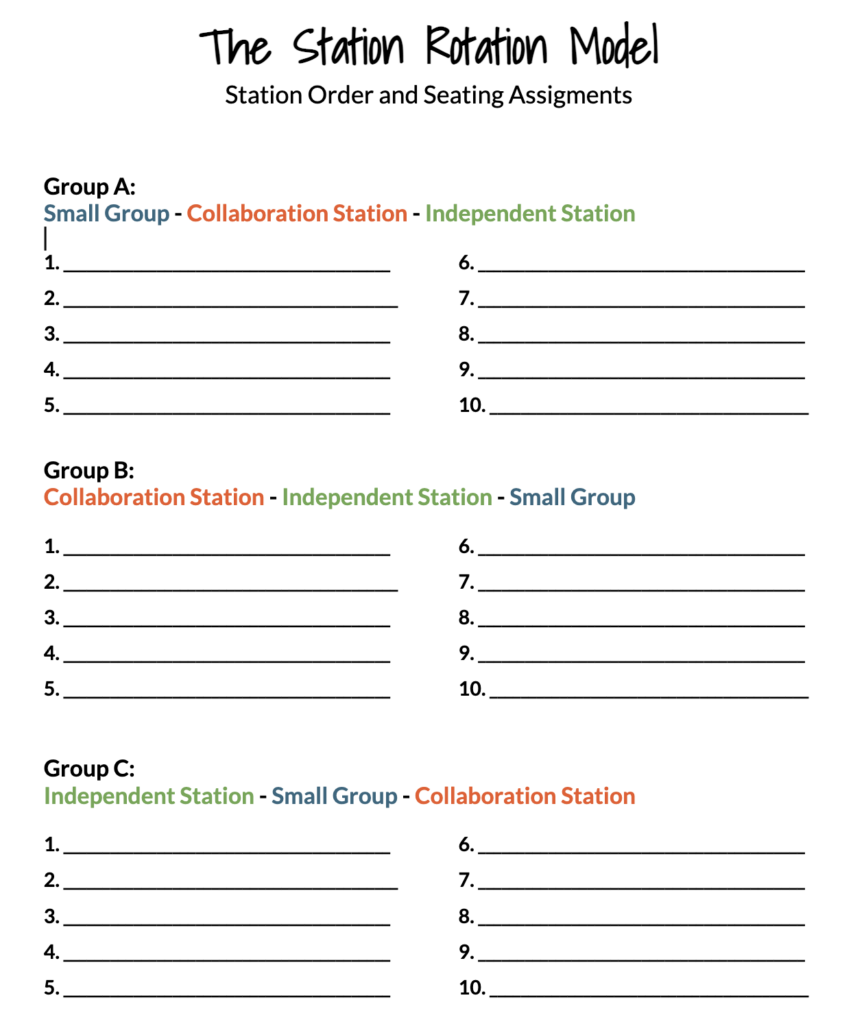Do you want to design lessons that allow you to work with small groups but worry about keeping the rest of the class on task?
Even the most experienced teachers find themselves teaching “that one class” that needs extra support and structure when implementing the station rotation model. As a classroom teacher, instructional coach, and now site administrator, I have curated several easy-to-implement tips to help teachers effectively implement and manage the station rotation model with even the most energetic classes.
Assigned Seats at Student-Led Stations
As a teacher, I always had seating charts for whole-group instruction. I looked at skill level, behavior, personality types, IEPs, and chronic absenteeism to determine the best place for my students to sit in the classroom. Seating charts help create an effective and positive learning environment and foster student collaboration. When I started implementing the station rotation model, I wanted to ensure that I could maintain that same atmosphere of engagement, focus, self-management, and respectful interactions at the student-led independent and collaborative stations.
I used various grouping strategies depending on the purpose of my station rotation, such as student skill level, interests, and strength in a group dynamic. But for those classes that needed extra structure during station rotation, I found assigning seats and strategically seating students in groups was equally important. By doing so, I could focus better on my work at the teacher-led station, and the student-led stations ran more smoothly.
When students entered the classroom on station rotation days, they were greeted by my station rotation seating arrangement document. They looked for their names to find out which station they would begin at and what number their name was assigned to. These numbers corresponded with the seat numbers at the student-led independent and collaborative stations. I printed and laminated my seating assignment document, so I could change groups and seat assignments as needed with a black whiteboard marker.
When we transitioned to stations, students at the independent and collaborative stations sat at their assigned numbered seats. If needed, they quickly referred to the poster before they sat down to work.

The Impact of Assigned Seats at Student-led Stations
These seating assignments helped maintain a productive culture during this student-led collaborative station in a variety of ways:
- Students in the same rotation group did not sit next to friends who might distract them, so they stayed on task.
- Students that tended to be introverted and shy didn’t all end up at the same table group where no one talked or shared; there was a balanced of personality types.
- Students who didn’t get along were separated even when I needed them in the same rotation group.
- Students didn’t “save” seats for their friends, which could cause another student to feel unwelcome.
- Students were placed in heterogenous or homogenous groups for collective learning within the station depending on the purpose and task of the collaborative station.
Seating assignments and the independent station also helped maintain a positive learning environment for many of the same reasons. I was able to separate students who shouldn’t sit together, and I was able to place specific student leaders strategically next to others that may need help during the independent station.
Sample Templates for Teachers
Teachers can print out their seating assignment chart as I did, project it from their computer, or post it in Google Classroom for students to view. Here are a couple of templates teachers can copy and use for seat assignments.
Here are a couple of other things to consider when implementing assigned seats for station rotation:
- Tape the seat assignments to the back of the chairs if you are concerned with students removing the seat numbers.
- Be flexible when needed. If three out of four students in one of the collaborative groups are absent, allow the single student to join another group.
- Be consistent with how you place your numbers, so you know immediately when students are not sitting where they should.
- Keep the seating assignment poster/document visible throughout the lesson so it is easy for you and your students to reference.
Assigned seating is nothing new in education and has many benefits. Implementing it during the station rotation model helps maintain the same productive and positive learning environment at the non-teacher-led stations.
Stay tuned for more easy-to-implement management tips!
R. Noelle Gutierrez has been working in public education for almost twenty years. She spent eleven years teaching English Language Arts and History at the middle school level. She then worked as an Instructional Coach for seven years, training and coaching secondary teachers in student engagement, standard-based strategies, curriculum development, and blended learning. During her time as an Instructional Coach, Noelle developed resources for Smarter Balanced. Noelle is currently working as a middle school Assistant Principal, where she continues to coach and train teachers.




